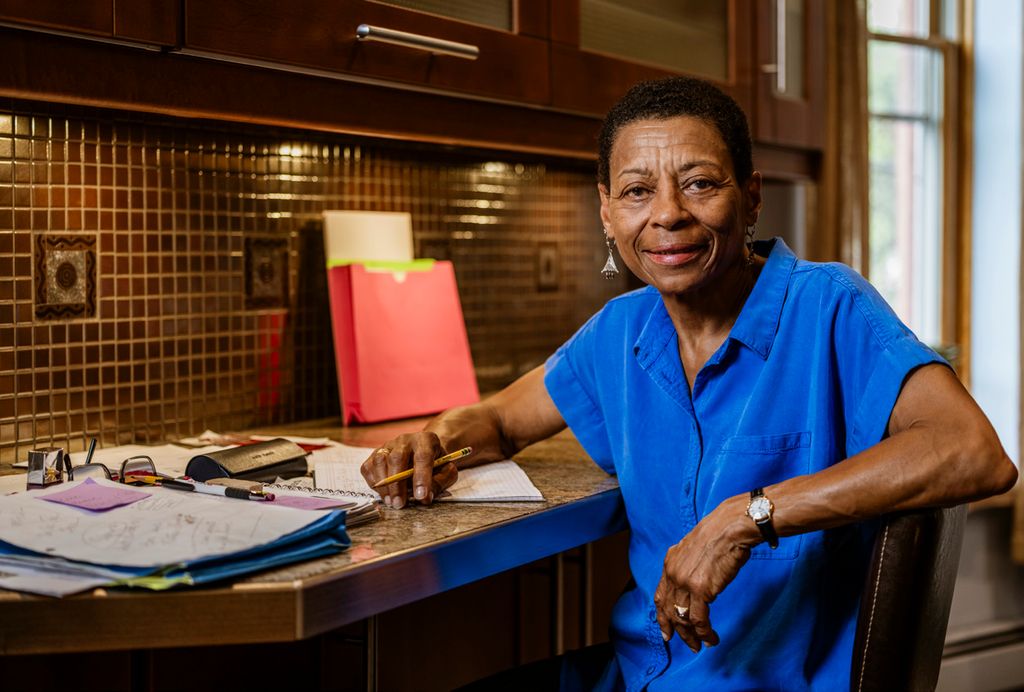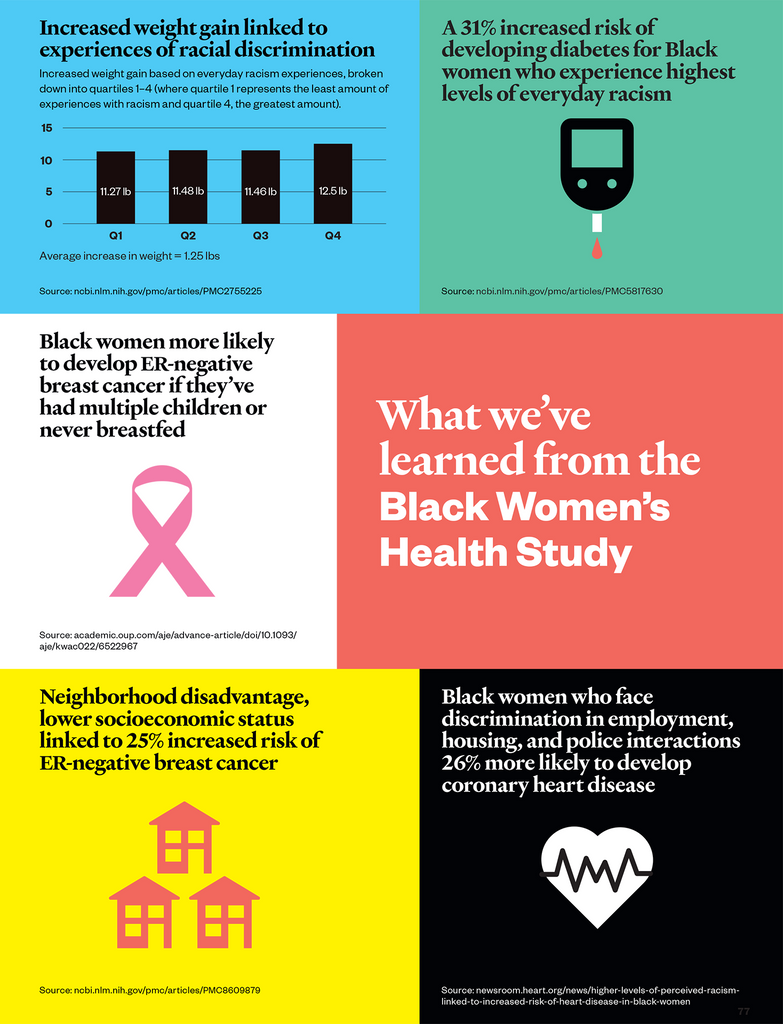Racism and Zip Codes, and Their Link to Black Women’s Health

[ad_1]
Charlene Coyne often thinks back to how her mother, Donna, struggled with severe hypertension for most of her life, battling complications that led to a heart attack and stroke when Donna was in her 30s.
Coyne also recalls the dismissive response from doctors when her mother voiced concerns about the severe side effects from the medication, such as blurry vision, severe headaches, and dizziness.
“I noticed a physical transformation and could see how toxic the drugs were for her,” says Coyne, a New York-based biopharmaceutical executive. But when Donna mentioned her symptoms to her doctor, he refused to change her treatment plan. “He insisted that he knew what he was doing,” Coyne says.
At age 43, Coyne’s mother passed away from hypertension complications, and her father later suffered a fatal heart attack.
Her family’s health history is in part what led Coyne to join Boston University’s Black Women’s Health Study (BWHS) 28 years ago, becoming part of the largest epidemiological study focused entirely on the health of Black women in the United States.
The study began in 1995 at BU’s Slone Epidemiology Center under the leadership of Lynn Rosenberg (GRS’65), professor of epidemiology at the School of Public Health and Slone senior epidemiologist, and Julie Palmer (SON’85, SPH’85), Slone director and a professor of medicine and epidemiology at BU Chobanian & Avedisian School of Medicine and SPH, respectively. Key input was also provided by collaborating investigator Lucile Adams-Campbell, then-director of Howard University Cancer Center (now at Georgetown University Lombardi Cancer Center).
The team sought to understand the underlying causes of poor health—and good health—among Black women.
Black women are more likely than other racial/ethnic groups to die from cardiovascular disease, hypertension, stroke, diabetes, and several cancers, but historically, they were all but excluded from clinical research, which focused primarily on White males.
“Women were just starting to be included in studies when I became an epidemiologist, and Black women weren’t included at all,” says Rosenberg, who stepped down from her role as a BWHS lead principal investigator earlier this year, but remains part of the core research team now led by Palmer, Yvette Cozier (SPH’94,’04), SPH associate dean for diversity, equity, inclusion & justice and associate professor of epidemiology; and Kimberly Bertrand (SPH’05), associate professor of medicine at the Chobanian & Avedisian SOM.
“We knew there was a dire need for this research,” Rosenberg says. “It was time for Black women to be included in studies.”
When I first heard about the Black Women’s Health Study, I said, ‘Thank goodness—someone finally cares.’
BWHS has published more than 350 papers over the years. The heaviest emphasis has been on breast cancer, but the findings span diabetes, obesity, autoimmune diseases, insomnia, and more.

“When I first heard about the Black Women’s Health Study, I said, ‘Thank goodness—someone finally cares,’” says Kim Bressant Kibwe, a Jersey City, N.J.–based participant and retired attorney. “We’re not all the same. There are many experiences that differ from one culture to the next.”
At 69 years old, Kibwe still wonders if the major surgery she received to remove uterine fibroids as a college student was medically necessary. BWHS research has shown that Black women are two to three times more likely than White women to develop fibroids.
Kibwe says she never questioned her doctor’s recommendation to remove one ovary and both fallopian tubes, nor his warning that she may become unable to have children. That possibility turned into reality.
“After the third time I tried to have children, at age 29 or 30, I said it just wasn’t meant to be,” she says.
In the decades of BWHS research, one observation has become increasingly clear: racism and other stressors may be much stronger predictors of poor health than individual choices or genetic differences.
The psychological trauma of racial discrimination may increase cortisol (the body’s stress hormone) and weaken the immune system, potentially leading to elevated blood pressure, memory problems and other conditions.
The 1997, 2009, and 2019 BWHS questionnaires asked participants about their past experiences with interpersonal racism, including daily, one-off encounters of perceived slights—such as poor service in a store or restaurant—as well as discriminatory treatment at work or in school, healthcare, the court system, housing, and interactions with police.
The researchers are also measuring the impact of structural racism, a relatively new term in public discourse that refers to the ways in which societies foster discrimination in policies or practices.
“Structural racism affects where people live, how they can exercise, the foods they eat, and the resources available to them,” says Palmer. “We didn’t have a name for it 20 years ago, but we have always acknowledged its influence on health, and we are continuing to examine how these racial experiences uniquely affect Black women.”
A close look at these racial disparities reveals another major predictor of poor health among Black women: zip code.

The historical legacy of slavery has cast a long shadow on policies and practices in the US. Consequent structural racism has shaped policies such as redlining that have resulted in lower rates of savings for Black American families. In turn, the country has been marked by substantial disinvestment in Black communities, which translates to fewer parks, fewer supermarkets with fresh and affordable foods, and higher levels of crime and air pollution.
Regardless of their income or education level, Black women are still more likely to live in disadvantaged neighborhoods compared to White women.
“We’ve come to realize how much one’s neighborhood environment and social structures, rather than genes, prescribe health outcomes,” says Cozier, an early BWHS investigator who studies how psychosocial stressors influence the development of autoimmune and immune-mediated diseases such as the difficult-to-diagnose sarcoidosis.
“We all have the same genes, but those genes are expressed differently across different groups of people, particularly in hyper-stressful or low-resource environments,” Cozier says.
Other prominent BWHS research focuses on estrogen receptor-negative (ER–) breast cancer, an aggressive subtype of breast cancer.
In 2014, Palmer led a landmark study that revealed Black women who have had more than one child, but who never breastfed, were more likely to develop ER– breast cancer, and this risk increased with each additional birth.
These findings debunk the common belief that women who do not have children are at increased risk of developing breast cancer. This risk is only true for estrogen-receptor positive (ER+) diagnoses, which are seen at higher rates in White women compared to Black women.
“We still don’t know why having babies without breastfeeding may cause this increased risk of breast cancer, but we can rule out genetics as the main cause,” Palmer says.
in 2021, Palmer led another pivotal study that developed and evaluated a breast cancer risk prediction model specifically geared toward Black women.
The newer tool is more effective than previous models, and it works best for women under 40. Both clinicians and individuals can access it on the Slone site to calculate one’s five-year risk for developing breast cancer.
Bertrand hopes to enhance the tool with data from a major study in progress to examine whether mammographic density (dense breast tissue) and other features on mammograms are useful predictors of breast cancer.
“There is well-established evidence that having denser tissue is a predictor of future breast cancer risk, even after 10 years,” she says.
The researchers hope their findings continue to spur awareness and action to close the gap in racial disparities and inequities in health, and they credit the success of BWHS to the dedicated participants who are still involved. “Our work would not be possible without their contributions,” Cozier says. “I hope they feel more vested and more seen as we work to understand with them the health issues that they experience.”
Explore Related Topics:
[ad_2]
Source link
